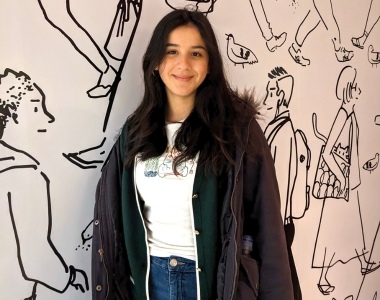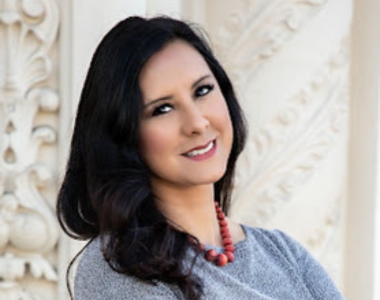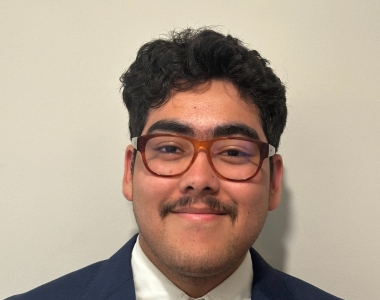From working in nursing at Cleveland Clinic to studying the impact of violence among youth, individuals of Hispanic heritage are engaged with countless facets of Case Western Reserve University.
In recognition of Hispanic Heritage Month, which takes place annually from Sept. 15 through Oct. 15, The Daily is celebrating the accomplishments and experiences of four Hispanic members of the CWRU community. Discover more about their experiences at the university—and learn how their heritage has impacted their lives.
Answers have been edited for clarity and length.

Martina Richter
Third-year biology student
Though she has familial roots in Peru, each year, Martina Richter challenges herself to learn the culture of different Latin countries. Growing up in Cleveland, Richter participated in a high school research program at CWRU where she began learning about social inequities related to healthcare access, which heavily influenced her career path.
“I knew I wanted to pursue healthcare, but now I would like to work at a community healthcare center and perhaps balance it with inpatient hospital work,” Richter said. “Working at Cleveland Clinic as a nurse’s aide has reinforced that I love being in healthcare settings and seeing how even small tasks like changing someone’s bed linens can improve their stay at the hospital.”
Read more from Richter.
Q: What are some important aspects about your culture? How do you/your family incorporate these things?
A: Important parts of Peruvian culture include the indigenous and pre-Columbian aspects of our culture. These include the ruling of the Incas and the Indigenous language, Quechua, [which] is seen through our most notable landmark, Machu Picchu. Other notable pieces of our patrimony include various dances that incorporate the vast amount of influences to our culture, such as alcatraz which have African roots.
My family mostly celebrates Peru’s diverse culture with the food we make and the traditions we uphold. My dad sometimes makes a special Peruvian dish, such as ceviche, while my mom and I go to church and afterwards we all enjoy the meal as a family.
Speaking with Hispanic patients that do not have English fluency has been important to me as well, as I believe that being unaware of what is going on in the hospital can increase stress and everyone has a right to have a say in what occurs to them while getting treated in the clinic.
Q: What does Hispanic Heritage Month mean to you?
A: Hispanic Heritage Month, in my opinion, celebrates the hard work that people put in everyday to make better lives for generations after them. It [recognizes] the hard work that we put into making our voices heard, even if we are the only person speaking up in our demographic, and the hard work we put into making sure that our culture doesn’t fade over the years. By having family dinner at my house and making our favorite dishes, we keep our culture present, despite [being] thousands of miles from our home country.
Q: What do you think the campus community should know about Hispanic Heritage Month in general?
A: I think that people should remember that Hispanic heritage includes so many different countries and cultures. For example, while many people believe that Cinco de Mayo is Mexico’s independence day, it’s not true! Their independence day is during Hispanic Heritage Month. Or, people may not know that one of Paraguay’s official languages, Guarani, is an onomatopoeic language, meaning that the language imitates sounds heard in nature.

Patty Zamora
Senior media relations specialist, University Marketing and Communications
While her family originated from Chile, Patty Zamora grew up in San Diego, where she later received a Bachelor of Arts in Communications degree from the University of California, San Diego. With over 20 years of experience in public relations, Zamora now supports the schools of medicine, nursing and occasionally dental medicine with their media relations needs.
“I love telling good stories that affect people and can possibly make a positive difference in the world,” Zamora said. “I may not be able to cure cancer, but if I can share the research of those trying to, then I feel I’ve contributed in a small way.”
Read on to learn more from Zamora.
Q: What are some important aspects about your culture? How do you/your family incorporate these things?
A: Food [such as] empanadas, pebre (salsa), ensalada Chilena (tomatoes and onions), marisco (seafood), carne (steak), and arroz (rice) are some Chilean dishes that my mom makes to this day that bring me back to my childhood.
Q: What does Hispanic Heritage Month mean to you?
A: We are a culture made up of various countries who value family and traditions that make us unique, yet unified as one. It doesn’t matter if you’re from Spain, Guatemala, Mexico or Chile—each country may have their own customs and traditions, but at the heart of it all, love for family and community is what we are all about.
Q: What do you think the campus community should know about Hispanic heritage in general?
During Hispanic Heritage Month, there is a chance to consider and, ideally, take in the diversity of the Latin American community in Cleveland and on campus. Puerto Ricans, Mexicans, Cubans, and people from so many other Hispanic nations are represented all across the region. Everybody has a rich heritage of traditions and rituals. We are a very hospitable people; therefore, I would hope that those who are unfamiliar with our rich culture will embrace it.

Matthew Centeno
Third-year biology and nutrition student
Since Matthew Centeno was a child, he has been fascinated by different science experiments and the complex systems that sustain life. A New York native with a Guatemalan and Peruvian background, Centeno relocated to Cleveland to attend CWRU, where he discovered various STEM programs at the School of Medicine that piqued his interest.
“I like to cook in my spare time, so I decided to take a nutrition class during my freshman year. The class ended up sparking a deeper interest in understanding how food and biology interact to influence health,” Centeno said. “I loved the class so much that it solidified my decision to major in biology and nutrition, combining my passion for science with a desire to explore the vital role nutrition plays in our well-being.”
Learn more about Centeno.
Q: What are some important aspects about your culture? How do you/your family incorporate these things?
A: An important aspect of my culture is that I regularly eat traditional Hispanic food. My mom often cooks Peruvian dishes with lomo saltado being one of my favorites. This dish, made with steak, French fries and a mix of onions and tomatoes, not only satisfies my taste buds but also serves as a reminder of where my parents immigrated from and deepens my connection to my cultural heritage.
Q: What does Hispanic Heritage Month mean to you?
A: To me, Hispanic Heritage Month means acknowledging the contributions and hardships of my ancestors, who paved the way for our place in the world. I take pride in the culture, art, food, and music that is all around me. and I’m grateful for the rich diversity of Hispanic nationalities that shaped the environment around me. I cherish these traditions and look forward to sharing them with others.
Q: What do you think the campus community should know about Hispanic heritage in general?
A: I think it is important for the community to know that Hispanic Heritage Month starts on Sept. 15 instead of starting on the first of the month because it is right before the independence day of several Spanish-speaking countries. Guatemala, Costa Rica, El Salvador, Honduras and Nicaragua all have their Independence Day on [Sept. 15].

Ivette Noriega
Senior research associate at the Begun Center for Violence Prevention Research and Education
Ivette Noriega’s passion in understanding the impact of violence in youth started in 2012 when she was a graduate psychology research assistant in El Paso, Texas, studying the impact of community violence and forced displacement. Today, Noriega continues her work in this area at CWRU—and has also incorporated a focus on public health and substance abuse.
“I am fortunate enough to use my language skills to help translate forms and reach out to underserved Spanish-speaking communities in the northeast Ohio region,” said Noriega, whose family is from present-day New Mexico and Chihuahua and Durango, Mexico.
Hear more from Noriega.
Q: What are some important aspects about your culture? How do you/your family incorporate these things?
A: An important aspect of our culture is education. One of my favorite memories is going to my grandparents’ house and seeing my parents, aunts, and uncles’ diplomas hanging on their living room wall. College and professional degrees from Mexico and other Latin American countries typically have the graduate’s head portrait printed on them, so it was very special seeing all of our family’s educational achievements and faces on that wall. Eventually, my brother and I were able to add our undergraduate and graduate degrees on that wall although those did not have the cool head portrait shot in them.
Q: What does Hispanic Heritage Month mean to you?
A: It is an opportunity to honor and recognize individuals from our culture who have paved the way in our field. It is also a month to celebrate the rich diversity and collective memory in Hispanic and Latin American communities.
Q: What do you think the campus community should know about Hispanic heritage in general?
A: Hispanic heritage is very diverse and rich. We have so many variations in culture, cuisine, language, history, and customs that it would take more than a month to be able to learn from all the diversity that exists within Hispanic culture.
